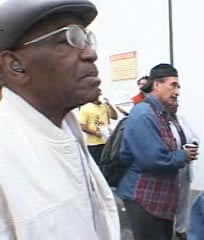 |
 |
 In the first two years of their electoral program, Community Voices Heard worked in districts in the south Bronx and Harlem, areas where they had “high density of membership in [and] that met the constituency that CVH had traditionally been working with,” Henry Serrano says.
In the first two years of their electoral program, Community Voices Heard worked in districts in the south Bronx and Harlem, areas where they had “high density of membership in [and] that met the constituency that CVH had traditionally been working with,” Henry Serrano says.
Why did they begin there? Henry explains that “the end of all this is not only visibility and making some changes around voter turnout, it’s also a first step toward getting people more engaged in the organization.” With that goal in mind, he adds, “we’ve tried to be strategic about where we’re picking to do the electoral work. Not only where it would be effective but also around where we could find a base that’s actually going to help build the capacity of the organization.” Watch Henry tell the story of how the strategic decision made by CVH membership to do voter work in New York City housing projects invigorated the organization with not only a new base but a new mission as well.
The projects Henry describes are classic examples of targeted turnout: integrated voter engagement in a limited segment of the population that centers around an organization's membership and base constituency. This is, in fact, the best place to start. Here are a few reasons why:
You know who you want to turnout, but how many of them must your organization turn out to make the impact you want to make? How much capital – financial, volunteer or paid labor, borrowed phone lines – will the project require? As Robby Rodriguez explains in the video, setting numerical goals for a turnout project is a balance between a realistic assesment of the “capacity” of the organization and ensuring that the results of the work will have the desired “significance” for your community.
Finding the right balance is, to some extent, a matter of trial and error. You may realize after the first project (or even midway through it) that your expectations outstretched the capacity of the organization, or vice versa. Henry admits that Community Voices Heard learned a great deal from the first year’s project, as he reveals in the video. He says,
“I think it’s a lot easier now to be realistic about how many people we’re expecting to reach and we’re expecting to move to the polls. And then I think there’s expectations about after the elections, how many people we want to go to leadership trainings and issue ID meetings.”
We’ll share ways to project capital needs – both financial and the people-power kind – later in the TechKit, but first you need to come up with two goals: how many voters you want to reach and how many you want to move to the polls.
Unfortunately, there’s no magic formula. The best lesson from the experiences of CVH (and any number of other organizations new to electoral work) is to develop a realistic attitude to what your program can accomplish in the first election cycle – and start small. Studies have found that election organizers have to contact about twelve people at their door in order to get one extra vote which wouldn’t otherwise be cast; that number drops to around eight if the contact occurs on the Monday before the election. Considering these statistics, getting 2,000 voters to the polls is no small feat – which policy makers and your allies will recognize.
Voter turnout work may take either approach. Organizations may pick a neighborhood where they’d like to build their membership and base, as SWOP has done in the west side of Albuquerque. As Robby Rodriguez explains, it’s “a fast-growing area that lacks many infrastructure needs and a lot of our members live there and want to start organizing there.” The demographic characteristics of the area match the organization’s goals, so while they are targeting geographically, it’s not as pointedly geographic as precinct-by-precinct strategies designed to win majorities in initiative campaigns.
On the other hand, trying to turn out voters that share certain demographic characteristics will most likely involve some geographic strategizing as well. SAGE Council has targeted Native Americans in Albuquerque, a group that is spread across the city, which makes voter outreach, especially door-knocking, more time-consuming and less efficient. They have, however, focused their energies on the areas where the community is concentrated.